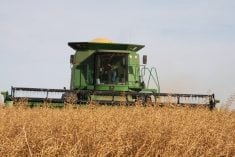Harvest just keeps getting sweeter for Alberta’s 208 sugar beet growers. The sector has seen a year-over-year increase in sugar beet quality and yield for much of the past decade. So what’s the secret to sweet success? Those closest to the sector suggest it’s a combination of climate, new varieties and sound grower management practices.
“In the last few years, we have increased our average yield by 30 per cent,” says Arnie Bergen-Henengouwen, President of Alberta Sugar Beet Growers, (ASBG). “That’s partly due to weather conditions, but I think the main driver would be improved varieties.”
Read Also

Claas brings 1000 Series SP forage harvesters to Canada
In mid-August, Claas unveiled its new line of Jaguar forage harvesters at an event in Visalia, California, deep in the heart of that state’s dairy region.
- Read more: These aren’t your father’s sugar beets
- Read more: Sugar beets just keep getting sweeter
Co-operative weather
Bergen-Henengouwen says Southern Alberta has seen warm, early season soil temperatures that allow for quick emergence. The crop also benefits from the region’s cool overnight temperatures in fall, when sucrose accumulation occurs.
Bergen-Henengouwen says since sugar beets are grown on 100 per cent irrigated land, dry weather is okay too. “We almost prefer drier climates so we can control how and when the water goes on,” he says. Pivot irrigation systems are common on sugar beet fields, and he says growers are able to be more efficient with water.
Experienced grower base, early adopters
In 2016, sugar beets hit another record yield, this time of 28.68 tonnes per acre.
“It wasn’t that long ago when 25 tonnes per acre would have been really, really good,” says Peter Regitnig, research agronomist with Lantic Inc., Canada’s only sugar beet processor. “Over the last number of years we’ve been scratching our heads as to what an average yield would be because it keeps going up.
Regitnig says part of the reason for increasing yields has to do with the ability of the grower base to respond to new opportunities. The sector is comprised of experienced growers that are early adopters of new varieties and practices.
“Sugar beet growers are very much early adopters, as are many growers that are doing row crops. They’re constantly looking for ways to improve. If there’s something out there they think is going to work, they’ll adopt it very quickly.”
The sector’s research program is funded on a 50/50 split between growers and industry. They also pick up additional dollars from seed companies for variety trials.
“Sugar beet varieties can be fairly fussy on climate and most of our varieties in Alberta are bred for this market,” says Regitnig.
Every year the variety testing program tests 24 to 30 sugar beet varieties. After three years, if those varieties meet or exceed currently-approved varieties for sugar beet quality and yield, they’re approved for growth in the area. The oldest variety grown in 2016 was approved in 2012.
“We’re continuing with variety improvements and trialing,’ Regitnig says. “We don’t seem to have hit a plateau yet. We always ask ourselves how high we can go.”
Quality can’t be beet
High yields are only part of the sugar beet success story — Regitnig says sugar beet quality has also been on the rise. High sugar content and low impurities are most desirable for processing.
In 2016 the sugar beet crop saw an average 19.31 per cent sugar content. The five-year average is 19.18 per cent. Regitnig says efficient use of nitrogen fertilizer, proper soil testing and crop rotation are also a help.
“Right now we’re probably the highest quality growing area in North America producing the highest sugar content,” Regitnig says. “For growers and for factory efficiency we want the highest quality beets we can get. Processing goes much better with a higher quality product.”
Nitrogen fertilizer use is one factor that has a significant impact on sugar content – too much brings sugar content down. Plant populations in the field too, play a role. In Alberta growers generally plant 150 beets per hundred feet of row, but there has been some suggestion from sugar beet growers in the U.S. that more might be better. Regitnig says the industry here will need to consider whether the smaller-sized sugar beets that result from those recommendations make sense for Canadian processing.
“We’re always trying to do it better, more efficiently so we’re using fewer resources and getting the same results,” Regitnig says.















